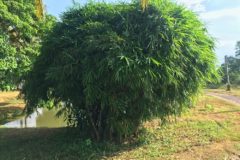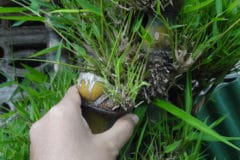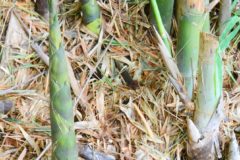Why Bamboo Needs Control Strategies
Bamboo counts among its more than 1,400 species the fastest-growing plants in the world. A mature running bamboo can literally grow new culms overnight, because the root mass is constantly pumping food and water to the rhizomes. Just as you control your lawn by mowing, you must control its grass family relative – namely bamboo – by root pruning and trimming.
Running or Clumping Bamboo
All bamboo belongs either to the running group or the clumping group, which affects growth habits and control strategies. For example, a clumping bamboo is easily contained by a barrier, while a running bamboo may just send a rhizome over the top of the barrier. Running bamboos send out horizontal rhizomes and grow new culms along the entire length, which is why they spread so fast.
Choosing Varieties
Clumping bamboo varieties are nearly always less difficult to control. Some bamboo is easier to control than others. These include:
- Fargesia nitida (Sinarundinaria nitida) – Chinese Mountain bamboo.
- Fargesia spathacea – Umbrella bamboo.
- Shibataea kumasasa – (No common name); least invasive of the runner bamboos.
- Pleioblastus pygmaeus (Arundinaria pygmaea) – Pygmy Bamboo; a vigorous spreader but small, so easier to control.
Using Barriers for Control
A good barrier can prevent bamboo from spreading – for a while. The disadvantage of a barrier is that, like a pot, eventually the bamboo plant will become root-bound. Some bamboo grow big enough to break the barrier and escape. However, a good, solid barrier of concrete, metal or heavy duty plastic can be a big help if well-maintained. Barriers should be three feet deep with a two-inch lip.
Trenching Bamboo
Trenching running bamboo makes it easier to keep the horizontal runners under control. Place a six-inch deep trench around the entire perimeter of the plant. Planting on a raised bed above the trench is even better. Runners will grow through the edge of the trench, where they can be easily seen and pruned with loppers, a sharp flat-bladed shovel or similar garden tools.
Control by Root Pruning
Biannual root pruning is the most widely-used strategy to control running bamboo, with or without the aid of a trench. Drive the spade straight into the ground to cut running bamboo’s horizontal rhizomes. Cut rhizomes back to within two feet of the plant. Be sure to remove any pieces of the roots, as otherwise they will sprout and grow new plants.
Planting Bamboo in Pots
Some people try the strategy of planting more invasive bamboo types in pots and sinking them into the ground, using the pot as a barrier. Unfortunately, the pot must have drainage holes, and the bamboo will often send rhizomes out the hole. This not only allows the bamboo to escape confinement, but means the horizontal rhizomes will be deeper underground and much harder to eradicate.
Growing Techniques
Cutting back on water and especially fertilizer can help keep bamboo from growing at what seems the speed of light. Not all bamboo will tolerate this technique, and many bamboos won’t spread, but they also will not be very healthy. However, bamboo in reasonable garden soil will usually do all right without fertilizer, so that is one acceptable strategy to keep it under control.
Overgrown Bamboo Control
Sometimes you buy or inherit property that has an overgrown bamboo clump. Drastic action may be necessary. Large clumps should be dug out with a backhoe. For running bamboo, the soil should then be sifted to remove all pieces of rhizome. If you decide to leave part of the clump, install a barrier to prevent problems in the future. Monitor the area for regrowth.
When Complete Removal is Necessary
If you must completely remove the bamboo, begin by cutting it to the ground. Apply 20 percent acetic acid (one brand name is Burnout), preferably on a hot day, to each culm as soon as you cut it. Cover the clump with a thick tarp for a few weeks. At that point, you can probably dig out the remaining root mass. Again, for running bamboo, sift the soil to remove rhizome fragments.












